cooling RENAULT KANGOO VAN ZERO EMISSION 2012 X61 / 2.G Owners Manual
[x] Cancel search | Manufacturer: RENAULT, Model Year: 2012, Model line: KANGOO VAN ZERO EMISSION, Model: RENAULT KANGOO VAN ZERO EMISSION 2012 X61 / 2.GPages: 220, PDF Size: 4.52 MB
Page 146 of 220
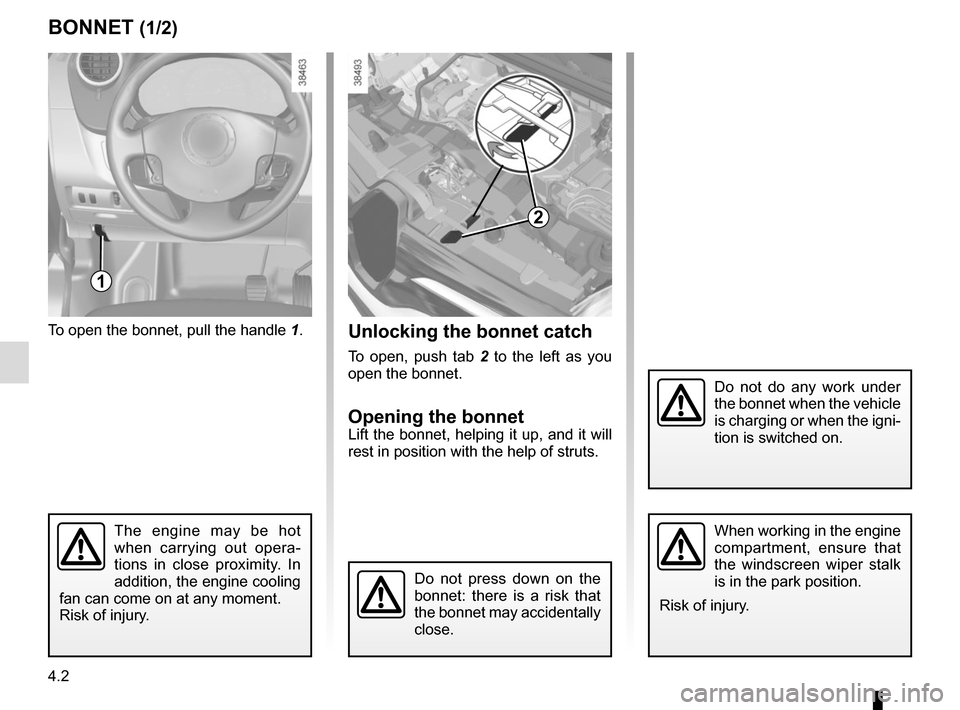
4.2
BONNET (1/2)
1
Do not do any work under
the bonnet when the vehicle
is charging or when the igni-
tion is switched on.
To open the bonnet, pull the handle 1.
The engine may be hot
when carrying out opera-
tions in close proximity. In
addition, the engine cooling
fan can come on at any moment.
Risk of injury.
Unlocking the bonnet catch
To open, push tab 2 to the left as you
open the bonnet.
Opening the bonnetLift the bonnet, helping it up, and it will
rest in position with the help of struts.
Do not press down on the
bonnet: there is a risk that
the bonnet may accidentally
close.
When working in the engine
compartment, ensure that
the windscreen wiper stalk
is in the park position.
Risk of injury.
2
Page 148 of 220
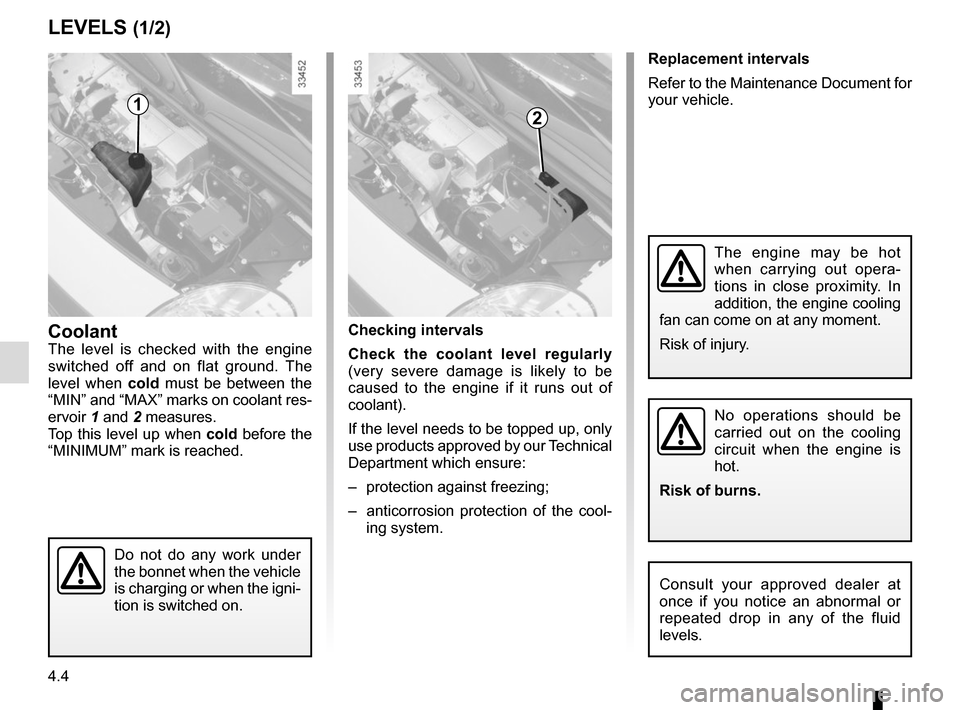
4.4
Replacement intervals
Refer to the Maintenance Document for
your vehicle.
LEVELS (1/2)
CoolantThe level is checked with the engine
switched off and on flat ground. The
level when cold must be between the
“MIN” and “MAX” marks on coolant res-
ervoir 1 and 2 measures. Top this level up when cold before the
“MINIMUM” mark is reached. Checking intervals
Check the coolant level regularly
(very severe damage is likely to be
caused to the engine if it runs out of
coolant).
If the level needs to be topped up, only
use products approved by our Technical
Department which ensure:
– protection against freezing;
– anticorrosion protection of the cool-
ing system.
No operations should be
carried out on the cooling
circuit when the engine is
hot.
Risk of burns.
Consult your approved dealer at
once if you notice an abnormal or
repeated drop in any of the fluid
levels.
12
The engine may be hot
when carrying out opera-
tions in close proximity. In
addition, the engine cooling
fan can come on at any moment.
Risk of injury.
Do not do any work under
the bonnet when the vehicle
is charging or when the igni-
tion is switched on.
Page 151 of 220
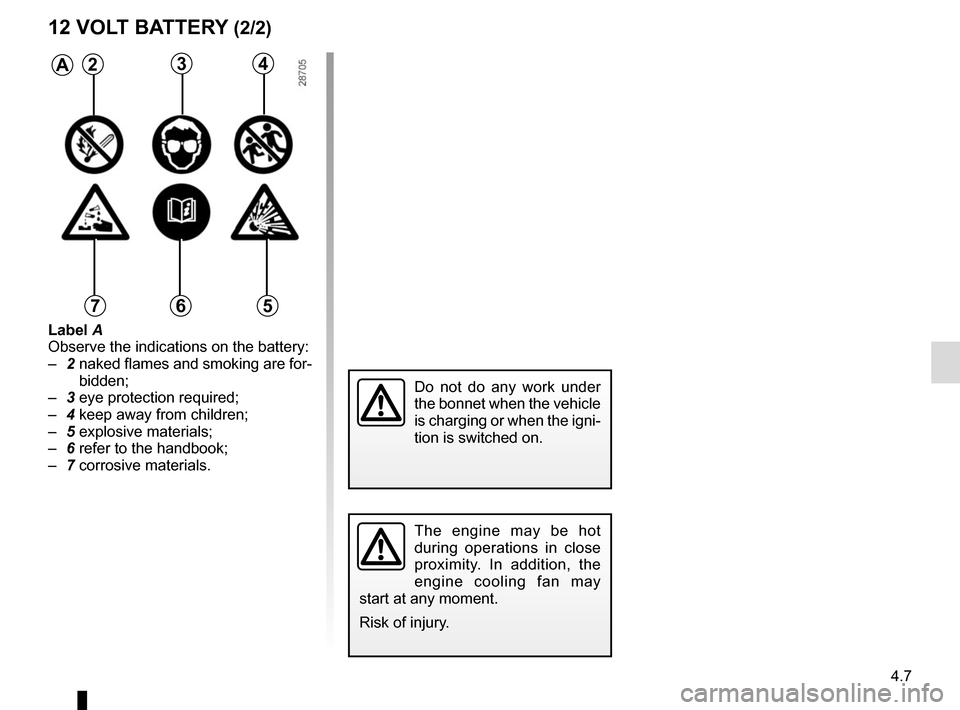
4.7
A234
567
Label A
Observe the indications on the battery:
– 2 naked flames and smoking are for-
bidden;
– 3 eye protection required;
– 4 keep away from children;
– 5 explosive materials;
– 6 refer to the handbook;
– 7 corrosive materials.
The engine may be hot
during operations in close
proximity. In addition, the
engine cooling fan may
start at any moment.
Risk of injury.
12 VOLT BATTERY (2/2)
Do not do any work under
the bonnet when the vehicle
is charging or when the igni-
tion is switched on.
Page 169 of 220
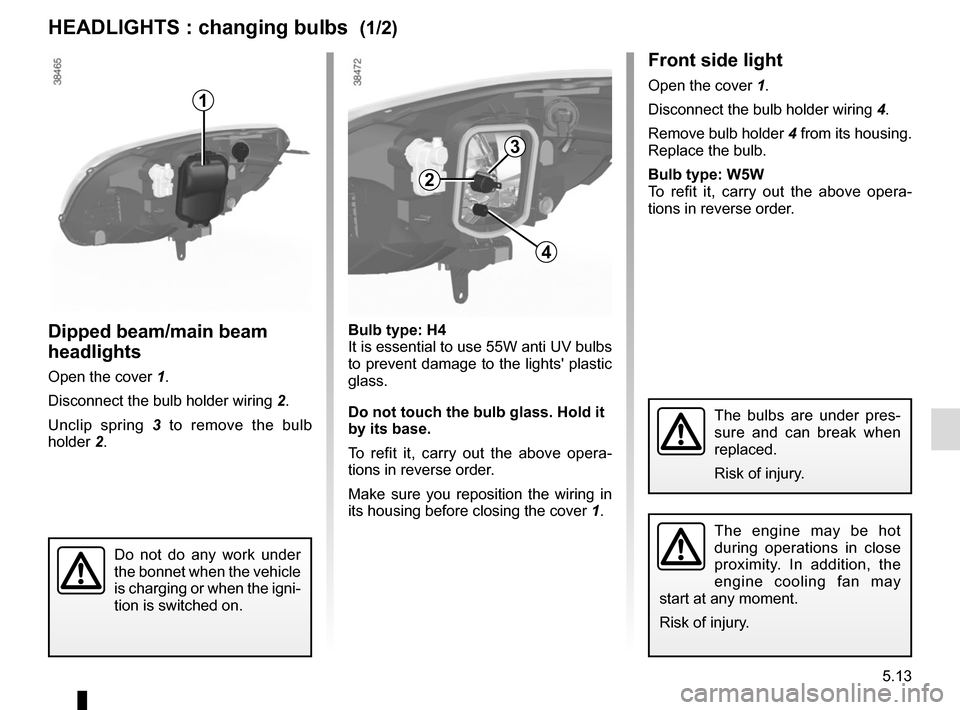
5.13
Front side light
Open the cover 1.
Disconnect the bulb holder wiring 4.
Remove bulb holder 4 from its housing.
Replace the bulb.
Bulb type: W5W
To refit it, carry out the above opera-
tions in reverse order.
Bulb type: H4 It is essential to use 55W anti UV bulbs
to prevent damage to the lights' plastic
glass.
Do not touch the bulb glass. Hold it
by its base.
To refit it, carry out the above opera-
tions in reverse order.
Make sure you reposition the wiring in
its housing before closing the cover 1.
The bulbs are under pres-
sure and can break when
replaced.
Risk of injury.
HEADLIGHTS : changing bulbs (1/2)
The engine may be hot
during operations in close
proximity. In addition, the
engine cooling fan may
start at any moment.
Risk of injury.
Do not do any work under
the bonnet when the vehicle
is charging or when the igni-
tion is switched on.
Dipped beam/main beam
headlights
Open the cover 1.
Disconnect the bulb holder wiring 2.
Unclip spring 3 to remove the bulb
holder 2.
2
1
4
3
Page 171 of 220
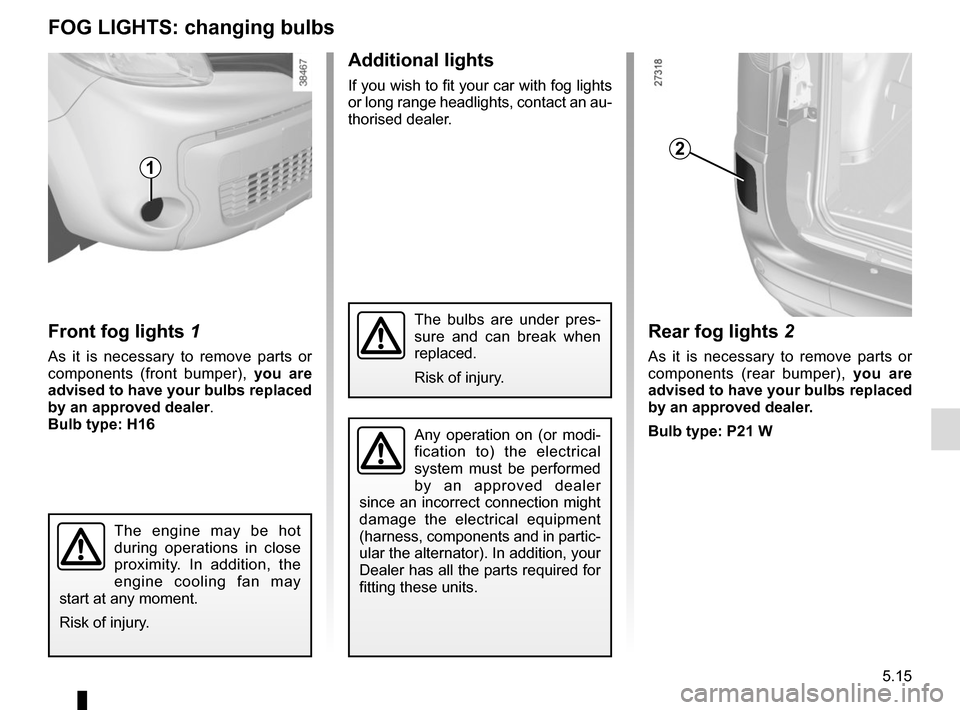
5.15
Front fog lights 1
As it is necessary to remove parts or
components (front bumper), you are
advised to have your bulbs replaced
by an approved dealer.
Bulb type: H16
Additional lights
If you wish to fit your car with fog lights
or long range headlights, contact an au-
thorised dealer.
FOG LIGHTS: changing bulbs
1
The engine may be hot
during operations in close
proximity. In addition, the
engine cooling fan may
start at any moment.
Risk of injury.
Any operation on (or modi-
fication to) the electrical
system must be performed
by an approved dealer
since an incorrect connection might
damage the electrical equipment
(harness, components and in partic-
ular the alternator). In addition, your
Dealer has all the parts required for
fitting these units.
Rear fog lights 2
As it is necessary to remove parts or
components (rear bumper), you are
advised to have your bulbs replaced
by an approved dealer.
Bulb type: P21 W
2
The bulbs are under pres-
sure and can break when
replaced.
Risk of injury.
Page 178 of 220

5.22
12 VOLT BATTERY: breakdown recovery (1/2)
To avoid all risk of sparks:
– Switch off the vehicle ignition.
– Ensure that any electrical consumers (courtesy lights, etc.) are switched
off before disconnecting or recon-
necting the battery.
– When charging, stop the charger before connecting or disconnecting
the battery.
– Do not place metal objects on the battery to avoid creating a short cir-
cuit between the terminals.
– Make sure that you reconnect the battery terminals after refitting.
Connecting a battery charger
The battery charger must be com-
patible with a battery with nominal
voltage of 12 volts.
Before disconnecting the battery, check
that:
– the ignition is switched off;
– the gear control is in position P
(please see the information on “Gear
control”;
– the charging cable is disconnected.
Special procedures may be
required to charge some
batteries. Contact your ap-
proved dealer.
Avoid all risk of sparks which may
cause an immediate explosion, and
charge the battery in a well-venti-
lated area. Risk of serious injury.
Handle the battery with care
as it contains sulphuric acid,
which must not come into
contact with eyes or skin. If
it does, wash the affected area with
plenty of cold water. If necessary,
consult a doctor.
Ensure that naked flames, red hot
objects and sparks do not come into
contact with the battery as there is a
risk of explosion.
The engine may be hot when car-
rying out operations in close prox-
imity. In addition, the engine cooling
fan can come on at any moment.
Risk of injury.
Disconnect the leads connected to both
battery terminals, starting with the
negative terminal.
Follow the instructions given by the
manufacturer of the battery charger
you are using.
Do not work on the 12 volt
battery (charging, replac-
ing, etc.):
– without switching off the
ignition;
– if your traction battery is charg- ing.
Please refer to the information
on “Electric vehicle: charging” in
Section 1.
Risk of serious injury.
Page 181 of 220

5.25
FUSES (2/2)
Number Allocation
1 Traction battery charger
2 Electric motor control unit
3 Air conditioning, pedestrian
horn
4 heating, brake lights,
traction battery
5 Rear windscreen wiper
6 Horn, diagnostic socket
7 Heated seats
8 Traction battery
9 Passenger compartment
ECU
10 Windscreen washer
11 Brake lights
12 Passenger compartment
unit, ABS, ESP
13 Electric windows, child
safety, heating and air
conditioning system, ECO
mode
14 Not used
15 Starter
12
3456
78910
11121314
15161718
19202122
23242526
27
28
29
Allocation of fusesThe presence of certain fuses de-
pends on the vehicle equipment
level.
Number Allocation
16 Brake lights, additional
equipment, navigation, ABS,
ESP, boot light, interior
lights, rain and light sensor,
charging warning light
17 Radio, navigation system,
display, alarm
18 Additional equipment
19 Heated door mirrors
20 Hazard lights, rear fog lights
21 Central locking of opening
elements
22 Instrument panel
23 Not used
24 ESP, radio, heating and air
conditioning system, heated
seats, stop lights
25 Front accessories socket
26 Towbar
27 Electric front windows
28 Rear-view mirror control
29 Engine cooling fan